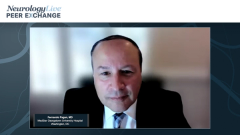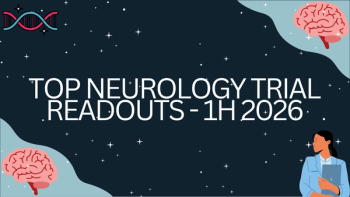
Challenges in Balancing Treatment of OFF Episodes and Dyskinesia in Parkinson Disease
The expert panel highlights challenges in treatment of OFF episodes and dyskinesia together and long-term consequences of delaying treatment for dyskinesia in patients with Parkinson disease.
Episodes in this series

Daniel E. Kremens, MD, JD: We have all touched on this point, there’s this thought that if a patient is dyskinetic, then they don’t have OFF time, they’re ON, and that’s a misconception. How common is it for patients to face both dyskinesia and OFF episodes?
Rajesh Pahwa, MD: I think the majority of patients have it. There are studies that show up to 80% of the patients who have dyskinesia also have OFF time. I think if you have dyskinesia, you definitely are having OFF time. You could have it the other way that you could have OFF without the dyskinesia, because now you are undertreating, so they’re never getting to a point that causes them to have the dyskinesia.
Daniel E. Kremens, MD, JD: Bill, do you think there are any long-term consequences potentially or complications for delaying treatment of dyskinesia?
William G. Ondo, MD: That comes down to how problematic you think the dyskinesia is biologically, I suppose. We don’t know whether dyskinesia is harmful to the brain in vivo. Now in theory, there are many reasons it could potentially be problematic. The free dopamine itself associated with dyskinetic states can be very problematic as it results in nonenzymatic metabolism of dopamine and significant oxidative stress. Dyskinesia is associated with increased glutamatergic tone, at least in the sense that blocking glutamate is one of the main treatments for dyskinesia in different ways. And increased glutamate is certainly positive to be problematic for the brain. But to my knowledge, there are no data in vivo in patients with Parkinson disease to say if there are any long-term deleterious consequences to prognosis just because of having dyskinesia. Now functionally, dyskinesia is problematic, as has been brought up, and one of the other main problems we see is social isolation, because although the patients are often not as aware of the dyskinesia themselves, other people are very aware. This both consciously and subconsciously results in less social engagement by patients having dyskinesia.
Daniel E. Kremens, MD, JD: What challenges do we face? If you have this patient who’s complaining about dyskinesia, but in your office they are OFF, what challenges do we face when we encounter those patients who are both dyskinetic and OFF? There are some data that suggest it could be 80% of patients or more. Bob, do you want to take a first stab at that?
Robert A. Hauser, MD, MBA: I think some of this we’ve touched on already. The biggest problem, rhetorically let’s say, could be dyskinesia. We have a problem identifying it to start with. The patient may not be aware of it, or may not know what to call it. You see them in the office, and maybe they are ON without dyskinesia in the 15 to 30 minutes that you’re seeing them. Or maybe they’re OFF, which might be even worse, because you’re thinking you need to increase medication. So right off the bat, we have these problems of identification and trying to understand where we want to head with medication. I think that’s what you were talking about or trying to get at, Dan.
Daniel E. Kremens, MD, JD: Yes. Fernando, do you want to say something?
Fernando Pagan, MD: I was just going to agree with Dr Hauser. Yes, absolutely we have a lot of challenges when we’re seeing these patients because as we know, 80% of them have both dyskinesia and wearing OFF. Which one do we treat first, and are they realizing it? Often our patients are coming in thinking that they are OFF, not necessarily that they’re dyskinetic, because they’re not realizing the fact that they have dyskinesia. They may be coming to you saying they’re having more falls or more difficulty with eating, etc. And you may not realize that it’s not all OFF, it’s also dyskinesia, because they may not be dyskinetic when they came to see you. This is a big challenge, so teaching your patients about both OFF and dyskinesia, and what ON is, is so important. These patients’ cases can be very challenging, so getting the history correct is important. Often having a family member is ideal because they can explain a bit more of what’s going on, because the patient’s family member is going to give a better history of what’s going on and being able to see that the patient is dyskinetic.
William G. Ondo, MD: The problem is that if you try to treat the OFF time with more dopaminergic medication, you tend to worsen the dyskinesia, and if you to treat the dyskinesia by lessening the dopaminergic medicine, you result in more OFF time. The only alternative is treating the dyskinesia with amantadine. The DR/ER [delayed-release/extended-release] preparation of amantadine is the only medicine to my knowledge that has been proven to help both with reducing OFF time and reducing dyskinesia, so that’s one of the options in that population.
Rajesh Pahwa, MD: I think we need to keep a couple of things in mind. The first thing is that patients can have slight dyskinesia that may not affect them at all. In fact, some patients will tell you, “The only time I’m dyskinetic is when I come to your office because you make me nervous.” Well, maybe not me, but coming to the office can make it obvious, but otherwise they don’t have dyskinesia. We need to keep in mind that treating that patient is different than patients who have dyskinesia throughout the day. Our other challenge is that even if a patient has mild dyskinesia, at least in the back of our mind it comes down to if we treat their OFF time, very likely we are going to make the dyskinesia worse. And even if at that stage the dyskinesia is not bad enough, adding something for OFF would cause that issue to get worse.
Transcript Edited for Clarity
Newsletter
Keep your finger on the pulse of neurology—subscribe to NeurologyLive for expert interviews, new data, and breakthrough treatment updates.
































